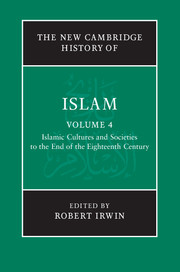Book contents
- Frontmatter
- Introduction
- PART I RELIGION AND LAW
- PART II SOCIETIES, POLITICS AND ECONOMICS
- PART III LITERATURE
- PART IV LEARNING, ARTS AND CULTURE
- 20 Education
- 21 Philosophy
- 22 The sciences in Islamic societies (750–1800)
- 23 Occult sciences and medicine
- 24 Literary and oral cultures
- 25 Islamic art and architecture
- 26 Music
- 27 Cookery
- Glossary
- Bibliography
- Index
- References
22 - The sciences in Islamic societies (750–1800)
from PART IV - LEARNING, ARTS AND CULTURE
Published online by Cambridge University Press: 28 March 2011
- Frontmatter
- Introduction
- PART I RELIGION AND LAW
- PART II SOCIETIES, POLITICS AND ECONOMICS
- PART III LITERATURE
- PART IV LEARNING, ARTS AND CULTURE
- 20 Education
- 21 Philosophy
- 22 The sciences in Islamic societies (750–1800)
- 23 Occult sciences and medicine
- 24 Literary and oral cultures
- 25 Islamic art and architecture
- 26 Music
- 27 Cookery
- Glossary
- Bibliography
- Index
- References
Summary
Introduction
The study of the non-religious scholarly disciplines in Islamic societies has mostly focused on elite writings, instruments and, occasionally, images. A vertical historical approach that compares texts, tables or instruments produced at different places and times has prevailed over a horizontal approach that situates a scholar within the complex environment of his time and space. The vertical approach favoured the comparison between ancient Greek achievements and those of scientists in Islamic societies. During recent decades a minority of historians of mathematics have focused on the comparison of achievements by scientists in Islamic societies with those of later Western scholars.
A corollary of the vertical approach is its preference for the study of outstanding achievements over more ordinary ones, the correct over the erroneous and the realistic over the symbolic. Historical questions such as whether mathematicians and astronomers in Islamic societies preferred Greek theories, models and methods over their Indian and Persian counterparts, and if so, why, have been answered primarily by pointing to cognitive superiority (better models, exact methods, more difficult subjects, axiomatic and deductive structure) to the neglect of other possible factors involved in such decisions. In contrast, the overarching theme of this chapter is the complex relationships between the work of scientists and physicians and the societies that they lived in.
- Type
- Chapter
- Information
- The New Cambridge History of Islam , pp. 564 - 639Publisher: Cambridge University PressPrint publication year: 2010
References
- 6
- Cited by



